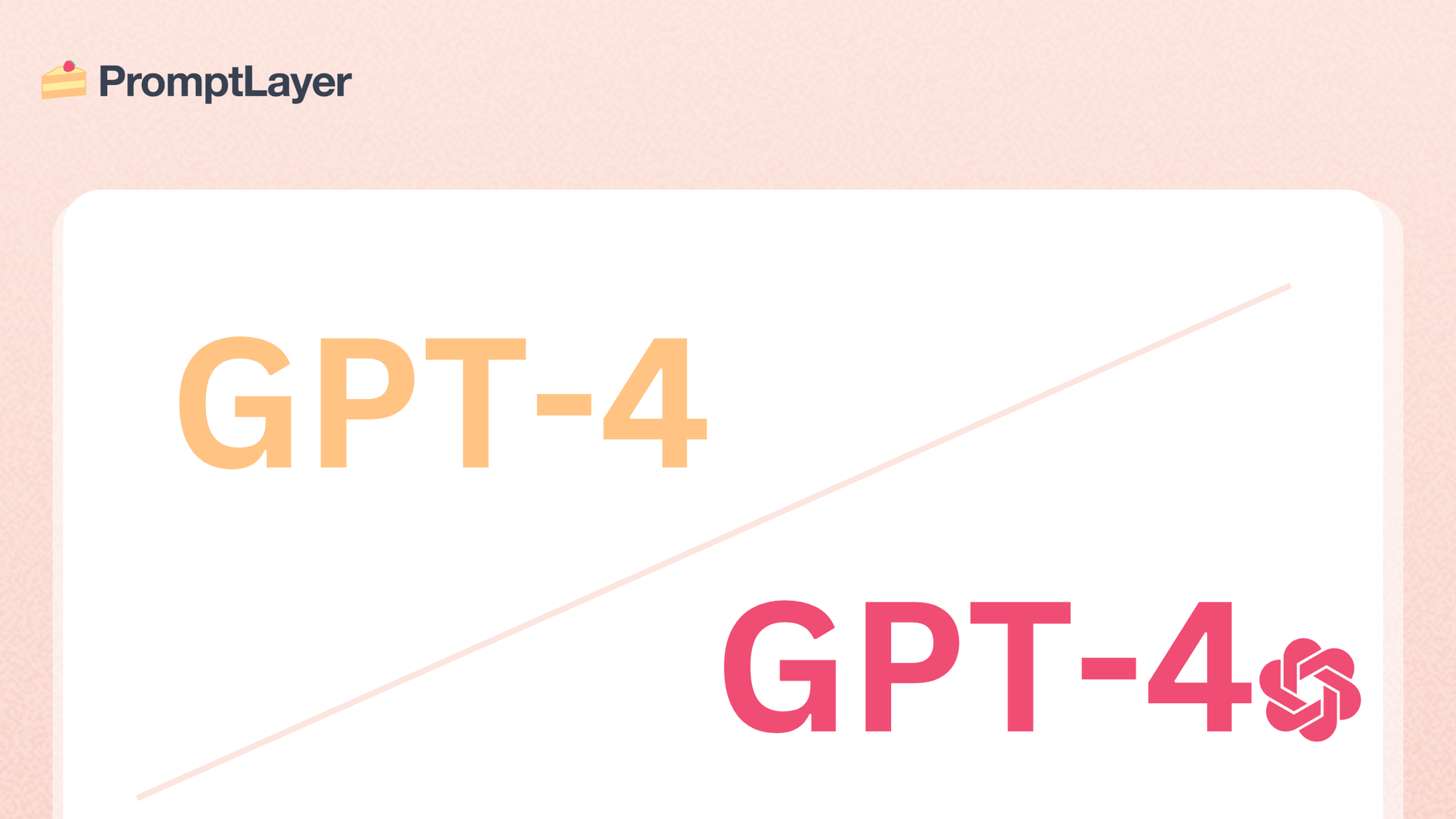Understanding GPT-4o vs GPT-4: A Comparative Guide

Table of Contents:
- What is GPT-4?
- What is GPT-4o?
- Cost Comparison GPT-4o vs GPT-4
- Overall Comparison GPT-4o vs GPT-4
- Key Differences GPT4o vs GPT-4
- Choosing GPT-4 vs GPT-4o
OpenAI's GPT model series have made big strides over the years, with GPT-4 and GPT-4o each bringing new strengths to LLMs. GPT-4 brought advanced reasoning, creativity, and deep comprehension, while GPT-4o introduced efficiency, expanded multimodal capabilities, and quicker response times.
In this article we'll highlight the key differences and similarities between the GPT-4o vs GPT-4 models. We’ll discuss where GPT-4o excels with multimodal tasks and cost efficiency, and whether you need to tap into GPT-4’s nuanced reasoning.
Knowing when and why to use each model will help you select the best option for your needs.
What is GPT-4?
GPT-4, launched on March 14, 2023, is the beginning of the fourth generation of OpenAI's language model.
It marked many improvements over GPT-3.5 enabling it to handle more complex conversations. One of the biggest improvements from GPT-3.5 were advancements in reasoning, creativity, and problem-solving. GPT-4 fathered the ability to complete new tasks like generating quality content to accurately answering analytical and coding questions.
GPT-4 is available through the ChatGPT user interface and via OpenAI’s API for developers.
What is GPT-4o?
GPT-4o (“o” for “omni”), launched on May 13, 2024, is an updated version of OpenAI’s GPT-4 model. It is designed with enhancements to both efficiency and accessibility.
With a 128,000-token context window for longer conversations, GPT-4o’s biggest improvement is the ability to process multiple data types—including text, audio, images, and video—within the model. It also boasts faster response times, cheaper cost per token, and lower latency, making it a prime candidate for real-time applications, multilingual tasks, and high volume jobs.
GPT-4o is also available through the ChatGPT user interface and via OpenAI’s API for developers.
Comparing GPT-4o vs GPT-4
To understand the differences in these models, let’s look at GPT-4 and GPT-4o’s costs, capabilities, specifications, and specializations side-by-side:
Cost Comparisons: GPT-4 vs GPT-4o
| Model | Input Tokens Cost | Output Tokens Cost |
|---|---|---|
| GPT-4 | $30 / 1M tokens | $60 / 1M tokens |
| GPT-4o | $2.50 / 1M tokens | $10 / 1M tokens |
Note: When using these models directly within ChatGPT, you are not charged per token. The cost analysis here pertains solely to API usage. Also, we are using information on GPT-4, not GPT-4-turbo.
PromptLayer lets you compare models side-by-side in an interactive view, making it easy to identify the best model for specific tasks.
You can also manage and monitor prompts with your whole team. Get started here.
Comparing Increases in Input and Output Token Costs
| Transition | Input Tokens Cost Increase | Output Tokens Cost Increase |
|---|---|---|
| GPT-4o to GPT-4 | 1,100% increase (12× higher) | 500% increase (6× higher) |
GPT-4o is significantly more cost-effective option compared to GPT-4, especially for API usage.
GPT-4o vs GPT-4 Overall Comparison
| Model | GPT-4o | GPT-4 |
|---|---|---|
| Model Description | Optimized successor to GPT-4; cost-effective and efficient. | Advanced flagship model for reasoning, creativity, and problem-solving. |
| Multimodal: accepts text, image, audio, and video inputs; outputs text, image, audio. | Primarily accepts text inputs; multimodal features with limited support for image inputs. | |
| 2x faster and 90% cheaper compared to GPT-4 in API usage. | Known for detailed and nuanced outputs, with a focus on high-quality content generation. | |
| Superior performance in non-English languages and tasks involving vision and audio. | Strong at advanced creative tasks and high-level problem-solving scenarios. | |
| Intelligence & Reasoning | High-level intelligence suitable for complex, multi-step tasks. | Known for deep intelligence, handling nuanced and sophisticated reasoning tasks well. |
| Highly efficient for broad language understanding and real-time translation. | Specialized in deep reasoning, advanced natural language understanding, and technical tasks. | |
| Internal Reasoning Process | Focuses on delivering quick, efficient, and context-aware responses. | Uses an internal chain of reasoning to enhance response quality ("thinks before answering"). |
| No explicit mention of extended reasoning chains. | Emphasizes thorough internal processing for highly detailed responses. | |
| Speed | Generates text up to 2x faster than GPT-4; optimized for lower latency and high efficiency. | Capable of detailed responses but tends to generate them more slowly due to deeper reasoning. |
| Cost | $2.50 / 1M input tokens; $10.00 / 1M output tokens—much more cost-effective. | $30.00 / 1M input tokens; $60.00 / 1M output tokens—higher cost reflects advanced features. |
| Multimodality | Accepts text, image, audio, and video inputs; capable of handling complex multimodal tasks. | Limited multimodal capabilities, primarily focused on text and some image inputs. |
| Specializations | Excels in multilingual tasks and vision-based capabilities. | Excels in intricate problem-solving, creative writing, and content generation. |
| Context Window | 128,000 tokens | 128,000 tokens |
| Max Output Tokens | Up to 16,384 tokens | Up to 16,384 tokens |
| Training Data | Up to October 2023 | Up to September 2021 |
| Ideal Use Cases | Tasks requiring speed, efficiency, and multimodal understanding. | Complex problem-solving, research, advanced content creation, and highly nuanced responses. |
| Multilingual applications and tasks involving audio or video inputs. | Tasks needing in-depth reasoning and creativity, such as academic research and storytelling. |
OpenAI GPT-4o vs GPT-4 Key Differences
| Model | GPT-4o Series | GPT-4 Series |
|---|---|---|
| Primary Focus | High intelligence with a focus on efficiency and cost-effectiveness. | Complex reasoning, creativity, and nuanced problem-solving. |
| Optimized for a balance of speed, accuracy, and multimodal capabilities. | Prioritizes sophisticated problem-solving and high-quality responses. | |
| Multimodal Support | Yes (supports text, image, audio, and video inputs; text, image, audio outputs). | Limited multimodal features, mainly focused on text input and some image capabilities. |
| Speed and Cost | Faster generation speed—up to 2x faster than GPT-4. | More advanced reasoning, often resulting in longer response times. |
| Much cheaper: $2.50 per 1M input tokens, $10 per 1M output tokens. | Higher cost: $30 per 1M input tokens, $60 per 1M output tokens. | |
| Optimized for quick responses, low latency, and efficient API usage. | Reflects its advanced features with a higher token cost. | |
| Ideal For | Applications requiring speed, multimodal interactions, and budget-friendly solutions. | Complex problem-solving tasks, in-depth research, and creative applications. |
| Multilingual tasks, real-time translation, and tasks involving audio or video inputs. | Specialized tasks needing nuanced understanding and in-depth analysis. | |
| Max Output Tokens | Up to 16,384 tokens | Up to 8,192 tokens |
| Training Data | Trained on data available until October 2023. | Trained on data through September 2021. Outdated by today's standards for new information. |
Choosing GPT-4 vs GPT-4o
In most situations, GPT-4o is a stronger option than GPT-4, with several factors contributing to this:
Cost and Efficiency: GPT-4o offers substantial savings, charging $2.50 per million input tokens and $10 per million output tokens—far more affordable than GPT-4's $30 and $60 rates, respectively. For high-volume token usage, GPT-4o delivers cost savings without compromising functionality.
Speed: GPT-4o generates outputs up to twice as fast as GPT-4. GPT-4’s complex reasoning often results in slower output, while GPT-4o achieves a balance of speed and precision.
Multimodal Capabilities: With support for text, image, audio, and video inputs, GPT-4o provides far more versatility than GPT-4. For applications involving varied content types, GPT-4o is a clear winner.
Training Data: Trained on data up to October 2023, GPT-4o has a more recent understanding of current developments, which is beneficial in fields that rely on up-to-date information. GPT-4, trained on data through September 2021, may lack context on recent advances and trends.
Reasoning and Intelligence: While GPT-4 is recognized for nuanced reasoning, GPT-4o balances high-level intelligence with efficiency. It performs complex tasks well, and its cost and speed advantages make it suitable for a wider range of applications. Only in cases needing more intricate reasoning might GPT-4’s depth remain preferable.
Token Limit: GPT-4o’s output token limit of up to 16,384 tokens doubles that of GPT-4, enabling longer, more detailed responses—especially useful for content generation and large document summarization.
When Might GPT-4 Be Preferred?
There may be a few niche situations where GPT-4 may still be relevant:
- Specialized Problem-Solving: For tasks requiring especially nuanced analysis, like academic research or complex writing, GPT-4 may provide an edge in depth and detail. However the new o1 models are also great options.
- Legacy Systems: Established workflows already tailored to GPT-4 might make switching less convenient, especially if current systems are deeply integrated with the model.
Conclusion
For most applications, GPT-4o is the better choice, combining lower cost, higher speed, broader multimodal abilities, and more recent data training. Unless an application specifically benefits from GPT-4’s detailed reasoning or has existing GPT-4 dependencies, GPT-4o is likely the more efficient and versatile option.
About PromptLayer
PromptLayer is a prompt management system that helps you iterate on prompts faster — further speeding up the development cycle! Use their prompt CMS to update a prompt, run evaluations, and deploy it to production in minutes. Check them out here. 🍰



